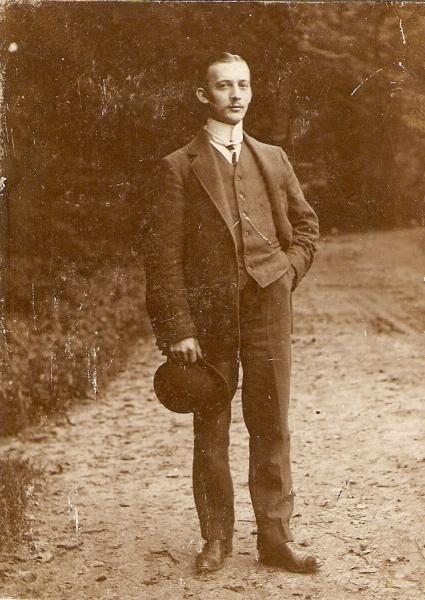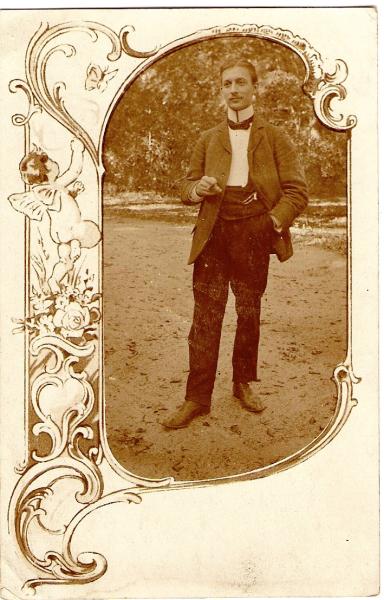This picture was probably taken in Scotia, Humboldt County; that is the place where Stefan found the last written document with George's name on it.


gusenbauer am 20. Januar 2013 | 0 Kommentare
| Kommentieren
Below you can see an old photography which Stefan believes shows George Henry Backenkohler as a nice gentleman living in America about a century ago. These pictures have been in our family's property, but no one knows for sure who is porttrayed in them.


gusenbauer am 20. Januar 2013 | 0 Kommentare
| Kommentieren
About 112 years ago, my great great uncle, Georg Heinrich Backenköhler, immigrated to the United States of America. After living in various places in San Francisco and North California, his trace was completely lost at the end of 1918. Three years ago, in April of 2009, my uncle Stefan started investigating the life of George Henry in California for the first time. Due to considerable and time-consuming research he found out that the latter is thought to have been living and working in a company town called Scotia in Humboldt County, California at the end of World War One. He was an employee of the Pacific Lumber Company, which was based in Scotia, a place that was part of the company until it filed bankruptcy in early 2007.
In 2011, my uncle and I traveled again to Humboldt County, wishing to go in for more in-depth research and solving the remaining mysteries surrounding George Henry Backenkohler. This detailed report is supposed to provide interested people of the internet community, family members in the US and in Germany, and future generations with all the information we have concerning this topic. For this reason I decided to post every article in both English and German so that everyone who does not speak German too can understand it.
(Lars Feyen)
On a hot summer day in 1975 I heard the Name George Henry Backenköhler for the first time. Frank Suter was visiting his relatives in Germany. He was the son of Magda Backenköhler, my grandfather’s sister. For this occasion, two aunts of mine, Olga Mahlstedt and Marga Hildebrandt, my mother’s cousin, Elfriede Krüger, and their families were present at my parent’s house on Fritz-Frerichs-Straße 6 in Zetel, Lower Saxony, Germany. My grandmother, being the widow of Captain Friedrich August Backenköhler and therefore aunt in-law of Frank Suter and Elfriede Krüger, was living at our place and joined this cheerful party. At this time, Frank did not speak German fluently. As a child, he indeed learnt the German language from his parents, but had not spoken any German since the time of World War One. Therefore, a large part of the conversation was in English, which was a challenge for me, since three years of learning British English at school could not enable anyone to talk to Americans. However, I was capable of understanding most of the conversation.
During this conversation, which took place in the shades of the old Panama Apple tree in our garden due to the hot weather, the whereabouts of all of the Backenköhler siblings were being discussed.
As far as I remember, Magda must have been the oldest one. She immigrated to California, as did her sister Anna and her brother George. Anna was believed to have returned to Germany due to the anti-German sentiments in the US during World War One. After many years I found out that this assumption was false. She namely returned to her home country in 1906, a few weeks before the earthquake took place in San Francisco.
Nobody knew what had happened to Georg. He was allegedly missing. And this circumstance did not leave me alone. How could a man vanish like this? Were there no registers of deaths or censuses? And why did not anyone know anything? Did he disappear himself? Or did the family not want to be involved with him? I do not remember who mentioned it, but someone assumed that he might have changed his name. But were there no records of that, either. I wanted to have all these questions answered and thus I began researching Georg Heinrich Backenköhler, even though it took me years before finding first traces. According to a letter sent to my aunt Marga on November 13th in 1941 by Henriette Backenköhler, a sister of Georg’s, no one had heard from Georg since 1906, so he had assumedly died during the San Francisco Earth Quake. But in the 1980's, while checking the San Francisco City Directory of that time, I found out that Georg had lived in that area until 1914. Did his sister, who lived in Bremen, only make a mistake? But Magda had also lived in the Bay area and must have known about his whereabouts.
Over the years, I found a lot of hints regarding his life. At this point, the latest trace is his registration for the American military filed in September of 1918 in the small town of Scotia, Humboldt County. Various journeys to California (including trips to the state archive in San Bruno, the state government in Sacramento, the Pacific Lumber Company based in Scotia, and the county administration in Eureka) took place. A trip to San Francisco and Scotia in April of 2011 with my nephew, Lars Feyen, did not expose any new leads, but it concluded in all traces being documented.
I am of the opinion that all the historic documents that are published, for example, at ancestry.com, will help finding a satisfying end to the life story of Georg Heinrich Backenköhler: whether he died of the Spanish flu, whether he fell victim to the anti-German resentments, whether he emigrated to Honduras, or whether he simply stayed in California with his name changed.
(Stefan Feyen)
In 2011, my uncle and I traveled again to Humboldt County, wishing to go in for more in-depth research and solving the remaining mysteries surrounding George Henry Backenkohler. This detailed report is supposed to provide interested people of the internet community, family members in the US and in Germany, and future generations with all the information we have concerning this topic. For this reason I decided to post every article in both English and German so that everyone who does not speak German too can understand it.
(Lars Feyen)
On a hot summer day in 1975 I heard the Name George Henry Backenköhler for the first time. Frank Suter was visiting his relatives in Germany. He was the son of Magda Backenköhler, my grandfather’s sister. For this occasion, two aunts of mine, Olga Mahlstedt and Marga Hildebrandt, my mother’s cousin, Elfriede Krüger, and their families were present at my parent’s house on Fritz-Frerichs-Straße 6 in Zetel, Lower Saxony, Germany. My grandmother, being the widow of Captain Friedrich August Backenköhler and therefore aunt in-law of Frank Suter and Elfriede Krüger, was living at our place and joined this cheerful party. At this time, Frank did not speak German fluently. As a child, he indeed learnt the German language from his parents, but had not spoken any German since the time of World War One. Therefore, a large part of the conversation was in English, which was a challenge for me, since three years of learning British English at school could not enable anyone to talk to Americans. However, I was capable of understanding most of the conversation.
During this conversation, which took place in the shades of the old Panama Apple tree in our garden due to the hot weather, the whereabouts of all of the Backenköhler siblings were being discussed.
As far as I remember, Magda must have been the oldest one. She immigrated to California, as did her sister Anna and her brother George. Anna was believed to have returned to Germany due to the anti-German sentiments in the US during World War One. After many years I found out that this assumption was false. She namely returned to her home country in 1906, a few weeks before the earthquake took place in San Francisco.
Nobody knew what had happened to Georg. He was allegedly missing. And this circumstance did not leave me alone. How could a man vanish like this? Were there no registers of deaths or censuses? And why did not anyone know anything? Did he disappear himself? Or did the family not want to be involved with him? I do not remember who mentioned it, but someone assumed that he might have changed his name. But were there no records of that, either. I wanted to have all these questions answered and thus I began researching Georg Heinrich Backenköhler, even though it took me years before finding first traces. According to a letter sent to my aunt Marga on November 13th in 1941 by Henriette Backenköhler, a sister of Georg’s, no one had heard from Georg since 1906, so he had assumedly died during the San Francisco Earth Quake. But in the 1980's, while checking the San Francisco City Directory of that time, I found out that Georg had lived in that area until 1914. Did his sister, who lived in Bremen, only make a mistake? But Magda had also lived in the Bay area and must have known about his whereabouts.
Over the years, I found a lot of hints regarding his life. At this point, the latest trace is his registration for the American military filed in September of 1918 in the small town of Scotia, Humboldt County. Various journeys to California (including trips to the state archive in San Bruno, the state government in Sacramento, the Pacific Lumber Company based in Scotia, and the county administration in Eureka) took place. A trip to San Francisco and Scotia in April of 2011 with my nephew, Lars Feyen, did not expose any new leads, but it concluded in all traces being documented.
I am of the opinion that all the historic documents that are published, for example, at ancestry.com, will help finding a satisfying end to the life story of Georg Heinrich Backenköhler: whether he died of the Spanish flu, whether he fell victim to the anti-German resentments, whether he emigrated to Honduras, or whether he simply stayed in California with his name changed.
(Stefan Feyen)
gusenbauer am 03. Januar 2013 | 0 Kommentare
| Kommentieren